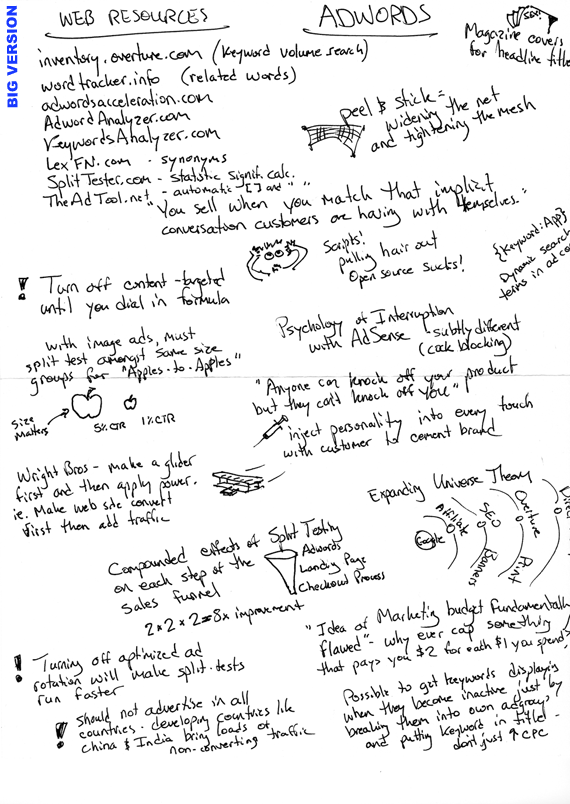I read a book on Adwords, watched most of the Google videos and have been tweaking our campaigns for JumpBox for the past 2wks. You can burn a lot of cash during the learning process. Here are ten things I’ve learned that will hopefully save others some time/money:
Custom-designed landing pages were actually detrimental (“jarring” effect)
This was completely counter-intuitive. Our original hypothesis was that it would be worth it to make a professionally-designed landing page stripping away most navigation choices because it would be more aesthetically appealing to a first-time visitor and better “corral” that person to the desired action. What we learned was that it had an adverse effect – conversion rates actually declined when we implemented these specially-designed pages. We achieved a better conversion rate by reverting to a standard page with all the regular look & feel and the same content. Our guess of what’s going on here is that having a landing page that looks nothing like what you get on the next click is either perceived as an ad or is just too visually jarring for the user. Visual consistency trumps design aesthetic and removing normal navigational elements yields no positive effect.
Fear of loss is a stronger motivator than promise of gain (“Fox news” effect)
This is something that my friend Dave Euse told me a long time ago and I’ve seen it confirmed first-hand with our adwords campaigns. While I’m not a fan of “Fox News” style scare tactics- it is more effective to say something like:
“What you don’t know about JumpBox could be costing you days of setup time.”
than something like this:
“You can save days of setup time with JumpBox.”
Think evening news segment teaser just before a commercial comes on. It’s a subtly different message but the idea is that people respond more to stop the prospect of losing $5 of their own money than to an equal opportunity of winning a new $5.
Web Optimizer is good for polishing but not sculpting (“bigger fish” effect)
Kimbro pointed this out and he’s 100% right- the Google Web Optimizer multivariate testing tool is helpful for fine-tuning messaging but it’s premature to use it until you have the fundamentals of the campaign ironed out. Until then there are bigger fish to fry in terms of getting the value proposition clear. We have an educational component to our stuff- the user doesn’t necessarily know how to describe their problem in terms that we can predict. The best thing to do in this situation is to forget about GWO until the point you have a good number of people already responding and then bring it in as an optimization.
Scientific method: control one variable at a time (“Apples to apples” effect)
This one is probably obvious but if you are trying to test a theory, don’t vary multiple elements at the same time. Control all the variables except the one you want to test. With Adwords there are many aspects of the campaign you can tweak and you may be tempted to vary multiple elements simultaneously to speed the testing process. Unfortunately the result will be that you’re unable to attribute the improvement or decline to a single variable when you do so. An example of this might be varying a headline while also changing the display URL – the effect from one may eclipse the other and hide minor effects. The other thing to keep in mind is you need to have a big enough sample size for your tests to be meaningful. There are plenty of free statistical significance calculators that will tell you if your results are truly significant.
The three phases of interaction: acquisition, conversion & retention
It’s helpful to think about the sequence of interaction in terms of these three phases:
Acquisition: the process of getting traffic to your site
Conversion: the process of converting those visitors to customers
Retention: the process of selling more stuff over time to your existing customers
Simple yes, but these are three independent activities with different challenges and different psychology. Thinking about them as three distinct activities will clarify what you need to be doing at each step.
Split test everything you do
Never stop split testing, ever. You should be running different flavors of your messaging in each of the above three phases. Google adwords has a built-in mechanism for running multiple variants of the same ad. Google web optimizer allows you to run multivariate and A/B tests on your site’s pages for the conversion process. And ideally you should be running A/B tests in the retention emails you send. I know Vertical Response is one service that supports A/B testing and I’m sure others do as well.
Analytics can help you visualize your funnel
You can see the click-path from both directions- from an entry page where the visitors went or from a final destination page and the various entry points that got them there. Make sure you have a google analytics account setup and integrated with your adwords and then go to the Content menu selection, click on the page you want to analyze and use the “Navigation Summary” and “Entry points” options. You should also ideally have conversion tracking set up on the thank you page of the intended action so you can tie specific campaigns and keywords to conversion.
Stumbleupon is a great way to get quick traffic for multi-variate testing
Stumbleupon is a firehose of semi-qualified trafic you can turn on at any time to expedite split testing. Keep in mind it’s blind traffic so it’s not a pure substitute to people that come actively searching for something, but it’s a quick way to accelerate the testing process. Have the Google Web Optimizer set up on the landing page and turn on stumble upon ads from an area of interest that most closely matches your target audience. You’ll get a flood of traffic very quickly and depending on how you set your tests up in GWO you’ll either see which version of the page or which combination of individual elements worked best. A/B testing produces a statistically significant result faster since they’re are fewer permutations. The other benefit of Stumbleupon traffic is the secondary wave of clicks that come from the social bookmarking component- you don’t pay for these so your paid campaign can actually seed an organic response if the page is well-received.
Dynamic text insertion
Contrary to what I thought, this is not just a technique relegated to the ebays of the world. These are the ads you see when you search for “steak knives” and see an ad that says “Buy steak knives on ebay.” Anyone can dynamically insert the search term into the text of the ad using this syntax:
{Keyword:search term substitute here}
The substitute word is used in the event that the search term is too long to appear in the ad. This tactic should be done in its own ad group and you should be aware that it generates a high volume of less-qualified traffic (make sure you have a tight daily cap on adspend and monitor closely when you try it). It also works very differently on content network vs. the Google search so you’ll need to experiment with it.
Crazy Egg can help provide clues to usage
Definitely try the free Crazy Egg service out on your landing page. It gives you a heatmap of user clicks and can provide interesting clues about how people are responding to your stuff. We learned the ineffectiveness of presenting a call-to-action too early in the dialogue before the user understood what we offer.
Other Resources

Here are some resources I used to get started: this Adwords book was a good primer- it’s by this guy Perry Marshall who really knows what he’s talking about. It had not just valuable info but it was motivating – all this stuff is useless if you don’t act on it. I posted my visual notes that give a good overview of the important takeaways from that book (I used this same style on the “Made to Stick” book and found it very helpful for retaining concepts). Google’s screencasts are a good starting reference but they’re a little slow – you might be able to figure it out faster via trial & error. Search for a local Adwords meetup in your city- I’m all for “high-bandwidth” face to face interaction in user groups for picking up tricks of the trade and getting answers once you have some experience and a list of questions.
I’m still extremely green to the whole Adwords game and making tons of mistakes as I go but hopefully this summary helps others who are just getting started. Improving conversion rate is crucial and our next big challenge now is to optimize our landing pages to better convert some of this traffic we’re now getting via Adwords. Minor improvements in conversion makes every bit of advertising you do more potent. In theory this process should reach a point where it’s a finely-tuned machine that accepts a dollar at one and and returns five at the other. I’ll report back with more lessons once we get it to that point.
 There are a lot of parallels between wind sports and startups. One thing we’ve encountered lately with JumpBox is something I can only describe as the tendency to “fight the wind” in our desire to artificially accelerate the pace of adoption. Everyone who’s tried to wind surf for the first time falls into the trap of trying to muscle the sail into position instead of respecting the wind and working with it. You end up completely wearing yourself out on that first day. By day two you’re so physically exhausted that your only option is to learn to work with the wind.
There are a lot of parallels between wind sports and startups. One thing we’ve encountered lately with JumpBox is something I can only describe as the tendency to “fight the wind” in our desire to artificially accelerate the pace of adoption. Everyone who’s tried to wind surf for the first time falls into the trap of trying to muscle the sail into position instead of respecting the wind and working with it. You end up completely wearing yourself out on that first day. By day two you’re so physically exhausted that your only option is to learn to work with the wind. 






